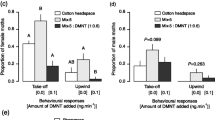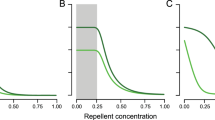Abstract
Plants release airborne volatile organic compounds (VOCs) in response to abiotic and biotic stimuli, including herbivory. These chemicals are used by insect parasitoids as sources of information that aid in finding hosts. It is unclear how biotic and abiotic factors interact to affect blend composition and the ability of insects to interpret signals. Here, we present a novel stimulus-space model, and use it to examine patterns of VOC emission. In field experiments, we manipulated herbivory levels and collected VOCs in a population of wild Datura wrightii, while simultaneously measuring key abiotic factors. We mirrored field experiments under controlled conditions in the lab, and used both sets of data to test predictions made by our proposed model. VOC blends were structured mainly by variation in abiotic factors, not herbivory. However, linear discriminant analysis showed that it is possible to distinguish different herbivory levels. We show that most compounds produced by D. wrightii are invariant, or respond solely to environmental variation or herbivory. Our results suggest that blend composition may be under selection for noise reduction, to maximize responses from potential receivers, and that abiotic variation can act as potentially strong sources of noise in chemical communication displays.








Similar content being viewed by others
References
Ackerson RC, Krieg DR (1977) Stomatal and nonstomatal regulation of water use in cotton, corn, and sorghum. Plant Physiol 60:850–853
Aitchison J (1986) The statistical analysis of compositional data. Chapman and Hall, London
Allison JD, Hare JD (2009) Learned and naive natural enemy responses and the interpretation of volatile organic compounds as cues or signals. New Phytol 184:768–782. https://doi.org/10.1111/j.1469-8137.2009.03046.x
Baldwin IT, Schultz JC (1983) Rapid changes in tree leaf chemistry induced by damage: evidence for communication between plants. Science 80(221):277–279. https://doi.org/10.1038/020493a0
Brumm H, Slabbekoorn H (2005) Acoustic communication in noise. Adv Study Behav 35:151–209. https://doi.org/10.1016/S0065-3454(05)35004-2
Caird MA, Richards JH, Donovan LA (2007) Nighttime stomatal conductance and transpiration in C3 and C4 plants. Plant physiol 143:4–10. https://doi.org/10.1104/pp.106.092940
Cheung YNS, Tyree MT, Dainty J (1975) Water relations parameters on single leaves obtained in a pressure bomb and some ecological interpretations. Can J Bot 53:1342–1346. https://doi.org/10.1139/b75-162
Copolovici L, Kännaste A, Remmel T, Niinemets Ü (2014) Volatile organic compound emissions from Alnus glutinosa under interacting drought and herbivory stresses. Environ Exp Bot 100:55–63. https://doi.org/10.1016/j.envexpbot.2013.12.011
De Moraes CM, Lewis WJ, Paré PW, Alborn HT, Tumlinson JH (1998) Herbivore-infested plants selectively attract parasitoids. Nature 393:570–573. https://doi.org/10.1038/31219
De Moraes CM, Mescher MC, Tumlinson JH (2001) Caterpillar-induced nocturnal plant volatiles repel conspecific females. Nature 410:577–580
Dicke M, Baldwin IT (2010) The evolutionary context for herbivore-induced plant volatiles: beyond the “cry for help”. Trends Plant Sci 15:167–175
Dudareva N, Negre F, Nagegowda D, Orlova I (2006) Plant volatiles: recent advances and future perspectives. CRC Crit Rev Plant Sci 25:417–440. https://doi.org/10.1080/07352680600899973
Dudareva N, Klempien A, Muhlemann JK, Kaplan I (2013) Biosynthesis, function and metabolic engineering of plant volatile organic compounds. New Phytol. https://doi.org/10.1111/nph.12145
Endler JA (1993) Some general comments on the evolution and design of animal communication systems. Philos Trans R Soc Lond B Biol Sci 340:215–225. https://doi.org/10.1098/rstb.1993.0060
Fisher RA (1936) The use of multiple measurements in taxonomic problems. Ann Hum Genet 7:179–188. https://doi.org/10.1017/CBO9781107415324.004
Garfin G, Jardine A, Merideth R, Leroy S (2013) Assessment of climate change in the southwest United States, vol 531. https://doi.org/10.5822/978-1-61091-484-0
Gouinguené S, Turlings TCJ (2002) The effects of abiotic factors on induced volatile emissions in corn plants. Plant Physiol 129:1296–1307. https://doi.org/10.1104/pp.001941.1296
Gouinguené S, Alborn H, Turlings TCJ (2003) Induction of volatile emissions in maize by different larval instars of Spodoptera littoralis. J Chem Ecol 29:145–162
Hare JD (2007) Variation in herbivore and methyl jasmonate-induced volatiles among genetic lines of Datura wrightii. J Chem Ecol 33:2028–2043. https://doi.org/10.1007/s10886-007-9375-1
Harley PC (2013) The roles of stomatal conductance and compound volatility in controlling the emission of volatile organic compounds from leaves. In: Niinemets Ü, Monson R (eds) Biology, controls and models of tree volatile organic compound emissions. Tree physiology, vol 5. Springer, Dordrecht
Heil M (2014) Herbivore-induced plant volatiles: targets, perception and unanswered questions. New Phytol 204:297–306. https://doi.org/10.1111/nph.12977
Heil M, Silva Bueno JC (2007) Within-plant signaling by volatiles leads to induction and priming of an indirect plant defense in nature. Proc Natl Acad Sci USA 104:5467–5472. https://doi.org/10.1073/pnas.0610266104
Holopainen JK, Gershenzon J (2010) Multiple stress factors and the emission of plant VOCs. Trends Plant Sci 15:176–184. https://doi.org/10.1016/j.tplants.2010.01.006
Junker RR, Kuppler J, Amo L, Blande JD, Borges RM, Dam NM, Dicke M, Dötterl S, Ehlers BK, Etl F, Gershenzon J (2017) Covariation and phenotypic integration in chemical communication displays: biosynthetic constraints and eco-evolutionary implications. New Phytol. https://doi.org/10.1111/nph.14505
Karban R, Baldwin I, Baxter K, Laue G (2000) Communication between plants: induced resistance in wild tobacco plants following clipping of neighboring sagebrush. Oecologia 125:66–71. https://doi.org/10.1007/PL00008892
Kessler A (2015) The information landscape of plant constitutive and induced secondary metabolite production. Curr Opin Insect Sci. https://doi.org/10.1016/j.cois.2015.02.002
Kessler A, Baldwin IT (2002) Plant responses to insect herbivory: the emerging molecular analysis. Annu Rev Plant Biol 53:299–328. https://doi.org/10.1146/annurev.arplant.53.100301.135207
Kessler A, Heil M (2011) The multiple faces of indirect defences and their agents of natural selection. Funct Ecol 25:348–357. https://doi.org/10.1111/j.1365-2435.2010.01818.x
Kessler A, Shiojiri K (2016) Plant secondary metabolites as an information channel mediating communitywide interactions. In: Arimura GI, Maffei M (eds) Plant Specialized Metabolism. CRC Press, Boca Raton, FL, USA, pp 13–20
McCormick AC, Unsicker SB, Gershenzon J (2012) The specificity of herbivore-induced plant volatiles in attracting herbivore enemies. Trends Plant Sci 17:303–310. https://doi.org/10.1016/j.tplants.2012.03.012
Mira A, Bernays EA (2002) Trade-offs in host use by Manduca sexta: plant characters vs natural enemies. Oikos 97:387–397. https://doi.org/10.1034/j.1600-0706.2002.970309.x
Miresmailli S, Isman MB (2014) Botanical insecticides inspired by plant–herbivore chemical interactions. Trends Plant Sci 19:29–35. https://doi.org/10.1016/j.tplants.2013.10.002
Niinemets Ü (2003) Controls on the emission of plant volatiles through stomata: differential sensitivity of emission rates to stomatal closure explained. J Geophys Res 108:1–17. https://doi.org/10.1029/2002JD002620
Niinemets Ü, Loreto F, Reichstein M (2004) Physiological and physicochemical controls on foliar volatile organic compound emissions. Trends Plant Sci 9(4):180–186
Oren R, Phillips N, Ewers BE, Pataki DE, Megonigal JP (1999) Sap-flux-scaled transpiration responses to light, vapor pressure deficit, and leaf area reduction in a flooded Taxodium distichum forest. Tree Physiol 19:337–347. https://doi.org/10.1093/treephys/19.6.337
Pareja M, Mohib A, Birkett MA, Dufour S, Glinwood RT (2009) Multivariate statistics coupled to generalized linear models reveal complex use of chemical cues by a parasitoid. Anim Behav 77:901–909. https://doi.org/10.1016/j.anbehav.2008.12.016
Potter KA, Woods HA (2012) Trichogramma parasitoids alter the metabolic physiology of Manduca eggs. Proc R Soc B Biol Sci 279:3572–3576. https://doi.org/10.1098/rspb.2012.1050
Rowen E, Kaplan I (2016) Eco-evolutionary factors drive induced plant volatiles: a meta-analysis. New Phytol 210:284–294. https://doi.org/10.1111/nph.13804
Scott-Phillips TC (2008) Defining biological communication. J Evol Biol 21:387–395. https://doi.org/10.1111/j.1420-9101.2007.01497.x
Shannon C (1948) A mathematical theory of communication. Bell Syst Tech J 27:379–423
Schulze ED, Hall AE (1982) Stomatal responses, water loss and CO 2 assimilation rates of plants in contrasting environments. In: Physiological plant ecology II. Springer, Berlin, Heidelberg, pp 181–230
Sprague JC, Woods HA (2015) Costs and benefits of underground pupal chambers constructed by insects: a test using Manduca sexta. Phyiol Biochem Zool 88:521–534. https://doi.org/10.1086/682251
Staudt M, Bertin N (1998) Light and temperature dependence of the emission of cyclic and acyclic monoterpenes from holm oak (Quercus ilex L.) leaves. Plant Cell Environ 21:385–395. https://doi.org/10.1046/j.1365-3040.1998.00288.x
Taiz L, Zeiger E (2002) Plant physiology. Sinauer Associates, Sunderland, MA, USA
Turner NC (1988) Measurement of plant water status by the pressure chamber technique. Irrigation Sci 9:289–308. https://doi.org/10.1007/BF00296704
Turlings TC, Ton J (2006) Exploiting scents of distress: the prospect of manipulating herbivore-induced plant odours to enhance the control of agricultural pests. Curr Opin Plant Biol 9:421–427. https://doi.org/10.1016/j.pbi.2006.05.010
Vickers CE, Gershenzon J, Lerdau MT, Loreto F (2009) A unified mechanism of action for volatile isoprenoids in plant abiotic stress. Nat Chem Biol 5:283–291. https://doi.org/10.1038/nchembio.158
Weldegergis BT, Zhu F, Poelman EH, Dicke M (2015) Drought stress affects plant metabolites and herbivore preference but not host location by its parasitoids. Oecologia 177:701–713. https://doi.org/10.1007/s00442-014-3129-x
Widhalm JR, Jaini R, Morgan JA, Dudareva N (2015) Rethinking how volatiles are released from plant cells. Trends Plant Sci 20:545–550. https://doi.org/10.1016/j.tplants.2015.06.009
Wilson JK, Woods HA (2015) Protection via parasitism: Datura odors attract parasitoid flies, which inhibit Manduca larvae from feeding and growing but may not help plants. Oecologia. https://doi.org/10.1007/s00442-015-3419-y
Wilson JK, Woods HA (2016) Innate and learned olfactory responses in a wild population of the egg parasitoid Trichogramma (Hymenoptera: Trichogrammatidae). J Insect Sci 16:110. https://doi.org/10.1093/jisesa/iew108
Wilson JK, Kessler A, Woods HA (2015) Noisy communication via airborne infochemicals. Bioscience 65:667–677. https://doi.org/10.1093/biosci/biv062
Woods HA, Wilson JK (2013) An information hypothesis for the evolution of homeostasis. TREE 28:283–289. https://doi.org/10.1016/j.tree.2012.10.021
Acknowledgements
Thank you to Erin McCullough, Emily Ding, Amanda Carrasco, Antoine Boussard, Valentina Giombini and Carter and Lolly Wilson for help with field work. Thank you to Erin McCullough, Anna Sala, Bret Tobalske and John Maron for comments on preliminary versions of this manuscript. Thanks to the director and staff of the Southwestern Research Station. This work was supported by the National Science Foundation (IOS 0844916) to H.A.W. and the University of Montana, as well as the NIH Postdoctoral Excellence in Research and Teaching Grant (K12GM000708) and the Department of Entomology and Center for Insect Science at the University of Arizona.
Author information
Authors and Affiliations
Contributions
JKW collected and analyzed data, with support from HAW in the field and lab. JKW, HAW and AK wrote the manuscript together.
Corresponding author
Additional information
Communicated by Richard Karban.
Rights and permissions
About this article
Cite this article
Wilson, J.K., Woods, H.A. & Kessler, A. High levels of abiotic noise in volatile organic compounds released by a desert perennial: implications for the evolution and ecology of airborne chemical communication. Oecologia 188, 367–379 (2018). https://doi.org/10.1007/s00442-018-4225-0
Received:
Accepted:
Published:
Issue Date:
DOI: https://doi.org/10.1007/s00442-018-4225-0




